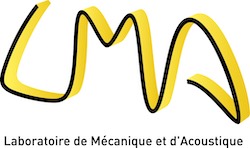Quentin Mesnildrey
Channel Interactions in Cochlear Implants : Do They Really Increase at High Current Levels ?
Résumé : Because of the conductive properties of the cochlea, the neural populations recruited by adjacent electrodes overlap. These channel interactions are thought to alter the transmission of sound information to cochlear implant (CI) listeners. Here we aim to better understand the relationship between these interactions and the stimulation level.
When considering a single electrode, an increase in level enables the recruitment of more distant neurons. One, therefore, often concludes that channel interactions should increase with current level. However, if we assume that channel interactions relate to the proportion of fibers stimulated by both electrodes relative to the total number of fibers excited, the effect of current level is more difficult to predict.
This question was investigated in a pitch discrimination task with CI users (Cochlear Corporation). On each trial, the subjects heard a reference and a test stimulus, presented in random order and had to indicate which one was higher in pitch. The reference stimulus consisted of two 300-ms duration, 80-pps interleaved pulse trains presented on both electrodes. The delay between the two pulse trains was equal to half a period yielding an “aggregate” temporal pattern of 160-pps pulse rate. This reference was compared to seven different test stimuli with rates ranging from 80 to 210-pps. For all test stimuli, the two electrodes were activated with a very short delay so that the aggregate temporal pattern was identical to the temporal pattern on each electrode. This task was repeated at two levels corresponding to 60%(soft) and 100%(loud) of the dynamic range and for two pairs of electrodes .
In this paradigm, the temporal pitch of the reference stimulus being judged close to 160Hz would suggest that the percept is dominated by neurons responding to the aggregate stimulus. In the opposite, a reference pitch judged close to 80Hz would indicate that the recruited neural populations were more independent.
Preliminary results show that the perceived pitch and its variation with the stimulation level are difficult to predict. Increasing the stimulation yielded a higher for 4 out of 11 conditions, a lower pitch for 5 out of 11 conditions and had no effect for two conditions. Increasing the electrode spacing yielded a decrease in pitch for all but one condition. The possible implications of these results as well as perspectives will be discussed.
Alexandre Hoffmann
Solving the full waveform inversion problem with a TR-SQP method
Résumé : Full waveform inversion (FWI) can be viewed as a nonlinear optimization problem where one tries to minimize a certain distance between a state variable and some observations of a wave field. Additionally, we require the state variable to be the solution of a model with some number of parameters. Typical approaches to solve the FWI includes the adjoint method, which generates a sequence of parameters and strictly enforces the model at each iteration, the wave field-reconstruction inversion (WRI) method, which generates a sequence of parameters and state variable and do not strictly enforces the model. The WRI is considered to be an interesting technique because, by virtue of not enforcing the model at each iteration, it extends the search space, and can thus find solutions that may not be found by a typical adjoint method. However, said method requires the tuning of a penalty parameter and do not ensure that the sequence of state variable converges to a solution of the model.
In the present work, we present a, to our knowledge, novel FWI technique which generates a sequence of parameters and state variable and which enforces loosely a linear approximation of the model. The method is based on a trust region sequential quadratic programming (TR-SQP) and uses the composite step method which minimize, at each iteration, both the residual relative to the model and the distance between the state variable and the observations. Moreover, at each iteration of the TR-SQP, the increment in both the state variable and the parameters is bounded into a certain sphere, which ensures the global convergence of the method.
The method is demonstrated by finding the first Lamée parameter of a simulated wave within a box with homogeneous Dirichlet boundary conditions.


